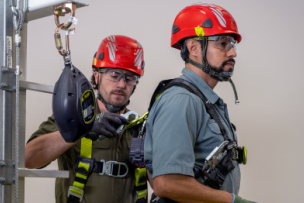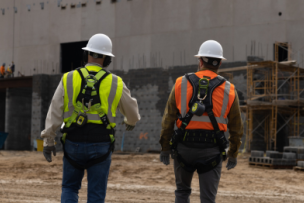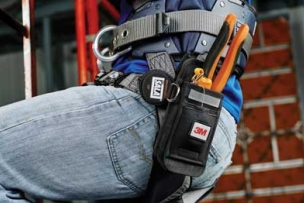Narrator: Welcome to Tooling Up, a series by MSC Industrial Supply Company that provides real-world insights brought to you by leading industry experts and aimed at improving the efficiency and productivity of your operations.
Eddie: What's up everybody? This is Eddie and welcome to our latest episode of MSC's Tooling Up featuring PRO-SAFE. So today we're going to be talking about, you guessed, it harnesses but not just harnesses, we're also going to be reviewing some of the do's and don'ts when it comes to implementing your fall protection program. So to give us insights on our topic today, we're going to be bringing in an industry leading expert from the MSC team, Bruno Cunha. Hey Bruno, thank you so much for joining us today. So before we get started, could you give us a quick insight on who is Bruno and what do you do for the team at MSC?
Bruno: Thanks Eddie, thanks for having me. It's great to be here. My name is Bruno Cunha. I've been with MSC a little over 10 years and most recently as a safety specialist in the northeast area and prior to that I was managing PRO-SAFE, which is an MSC exclusive brand in the safety category.
Eddie: Well very good, we thank you so much for joining us. So as we get things rolling today, we're going to talk a lot about the do's if you will when it comes to fall protection, but we need to initially discuss some of the biggest mistakes that individuals are making every single day. So do you want to highlight a couple of those factors that we need to be considering as we build out our fall protection programs?
Bruno: Sure, so fall protection can be pretty complex. The harness is one of the main components of a fall protection program. Unfortunately, it's also the one that users tend to be a little bit more comfortable with, but what I've been seeing is many are making mistakes just putting them on and that could cause some serious injuries obviously. The obvious one is a fatality, but in other cases you have times where you could fall out of the harness incorrectly, you could have some major pressure points on major organs, limbs, you could potentially have fractures and usually you're working at serious heights and the rescue team may not be able to get to you quick enough, so the last thing you want to do is be dangling in an uncomfortable position for any extended amount of time.
Eddie: No, which makes sense and there are obviously clear consequences to not taking this type of program seriously and I know as much as we love to say there's a one-size-fits-all for harnesses, that's clearly not the case. You want to tell us a little bit about that?
Bruno: Sure, the biggest misconception is that you're getting a size similar to the way you would size clothing. So if you wear an extra large T-shirt, the obvious assumption is I'm going to wear an extra large harness. That's not necessarily the case. So, many manufacturers provide sizing charts and the sizing chart is a great way to identify the appropriate size of harness that you need. The one we're seeing here on the screen is specific to the PRO-SAFE item that you're wearing and it's as simple as identifying your weight and your height and that'll give you your appropriate size.
Eddie: Hey, simple enough and in addition to some of the things you previously mentioned, are there any other additional consequences that everyone should be aware of as they're planning out their fall protection programs?
Bruno: Sure. So the appropriate way to put on the harness is pretty critical and identifying some of the features on the harness is a great way to do that. So what I always recommend is, for especially a novice user, to grab the harness by what we call the dorsal D-ring and if you turn around I could show the audience where that is. And that's that D-ring right in the center of Eddie's back here and he has it perfectly positioned in between the shoulder blades. It's not too high on the back, it's not too low. It shouldn't be to the left or to the right. You want it exactly the way Eddie has it on there and that provides some great structure where you're not going to fall out of the harness. In addition to that, once you have that harness in front of you, you simply put it on like a jacket. Eddie, it looks like you've done a great job putting this one out.
We'll just go through some of the key areas here. That top strap is your chest strap. You should be able to fit two fingers under the strap comfortably, not too tight, and definitely not too loose. The same with your belt buckle there and that functions just like a normal belt and then on your legs you want them snug. Again, not too tight and definitely not too loose, and you should be able if you go into a squat position your harness shouldn't move at all. So you obviously did a great job putting this on there.
Eddie: I tried my best. There are lots of individual parts but you make it relatively easy. So are there any other key safety features regarding this harness that we need to be aware of?
Bruno: Absolutely. As I mentioned earlier, comfort is a really important aspect not only to fall protection harnesses but to any personal protective equipment. I've walked into factories where if my safety glasses don't fit comfortably I have them on the top of my head. Totally defeats the purpose. Same thing with the harness. So your harness is actually the style of harness that you're wearing there is actually equipped with an air pad. And on the back of that dorsal D-ring, air flows right through it so you're always comfortable. Any perspiration that you're having gets wicked away much more so than a non-standard harness. In addition to that, if you notice that top buckle on your chest strap, that's what we call a quick connect. So it has two components that have to be engaged at the same time in order to take it out so you could disengage it relatively quickly. The benefit of a quick connect is for the most part, once you size that chest strap it's easy to put on and put off. You don't have to adjust too much. The belt buckle is your traditional tongue and groove, so it works just like a regular belt and it looks like you have the quick connects on the bottom there of the leg straps. No one type of fastener is going to keep you safer than the other. It comes down to ease of use and whatever you're comfortable with because again, if you're finagling with something that you can't put on, you can't adjust correctly, it could be detrimental and not sizing it properly.
Eddie: Yeah, 100 percent, and in addition to harnesses and an entire fall protection program, there obviously has to be a lot of safety training involved. So tell us a little bit about that and what individuals can expect and try to implement as they build out that fall protection program for themselves.
Bruno: Sure, absolutely. So every year OSHA publishes their top 10 violations and for 10 years in a row, fall protection has been number one on that list. Several years ago they also added a different standard for training requirements and that one's now also made it to the top 10. It's actually number eight, so there's still definitely a ton of education that has to go into fall protection programs in general and now specifically for training. So from a training standpoint, the individual user should be inspecting the harness every single time they put it on and they put it off. And the things that you're looking for are rust on the connection points, any frays or abrasions on the webbing itself. Make sure the inspection tags are on the harness. There's, for the most part, there's wear indicators. If those wear indicators have been engaged, you cannot use the harness.
One thing I didn't mention before is any fall protection equipment that has engaged in the fall has to be decommissioned so you can never wear that again. You actually have to destroy it so it's one critical part as well. Even if it's a minimal fall, you still have to remove it from service.
Eddie: No, interesting and so I'm sure with all this training, there's probably a general guideline or a punch list if you will of some key items that we should be considering. What are some of those items that we should really take seriously?
Bruno: Sure, so the list itself could be pretty extensive. There's close to 15 individual subparts in the training standard but some of the key critical ones are the employer must identify a height hazard. So within general industry, any heights above four feet are deemed to have some type of fall protection. That could be a guard rail, that could be a harness with the lanyards and anchor points, it could be a slew of different things, but the employer must identify that hazard. Once that hazard's identified, annually they must train any employee that's exposed to that hazard on the proper fall protection equipment and procedures that they should have in place. That annual training has to be done by a qualified person which OSHA defines as one that's capable of identifying existing and predictable hazards and, most importantly, has the authority to take protective measures should they encounter an issue. And that could be something like taking the harness out of service, providing a different type of fall protection equipment to use. One of the things that I see often missed is anytime there's a new employee that comes into a new job function, that employee must be trained on that hazard as well. They cannot wait for that annual training. Many employers have annual trainings once a year, but if there's a new employee who hasn't done a specific task and it's requiring fall protection, they must be trained immediately before taking that task. In addition to that, if there's a change in the process, so something happens on the job task itself, all employees must be retrained immediately.
Eddie: No, definitely an extensive list and it needs to be to ensure that we're really implementing proper safety within these programs. So in addition to everything that we've just mentioned, are there any other best practices that our viewers should be aware of as they build out and implement their new fall protection programs?
Bruno: Yeah, I think one of the most important things is if you are a user of fall protection equipment, inspect the products every time you're putting them on. If you have any doubt, toss it out, get another harness, talk to your supervisor, run by him why you think that the harness or the equipment they're using does not meet the requirements for the task and ensure that that's done because the last thing if I've been at heights, I have a little bit of a fear of heights, so I know I'm checking that harness to the T. I'm checking every single thing that I've been trained on and that's the one thing I definitely pass on especially to novice users. And then from the employer standpoint, any type of training that's required, you have to ensure that it's done in compliance with the OSHA standards. And again, the biggest missed has been new employees doing new tasks or a change in the job tasks themselves. That could solve a lot of the problems we see.
Eddie: No, this is all great information that we've covered because we've not only discussed some of the biggest mistakes, also some key features for not only this harness but harnesses all over and then lastly, ending it with things that we can personally do in response and to really fully implement that true fall protection program. So again, great information. For those who are looking for more info on either this harness or some of the other safety options that PRO-SAFE offers, where can we get more info?
Bruno: Sure, MSC has a great website, it's mscdirect.com/bettermro/safety. It has a ton of resources not only on fall protection safety but fall protection in general, both personal protective equipment and facility safety equipment, a ton of great resources, a ton of great ties back to OSHA and really everything that you need to keep yourself, your employees safe.
Eddie: There we go again, wonderful insight. We appreciate you so much for everything you've provided in this segment today Bruno and thank all of you viewers for checking out our latest episode of MSC's Tooling Up featuring PRO-SAFE.
Narrator: Want more insights and ideas to improve the efficiency and productivity of your operations? Subscribe to our channel so you never miss out.




Talk to Us!
Leave a reply
Your email address will not be published. Required fields are marked *